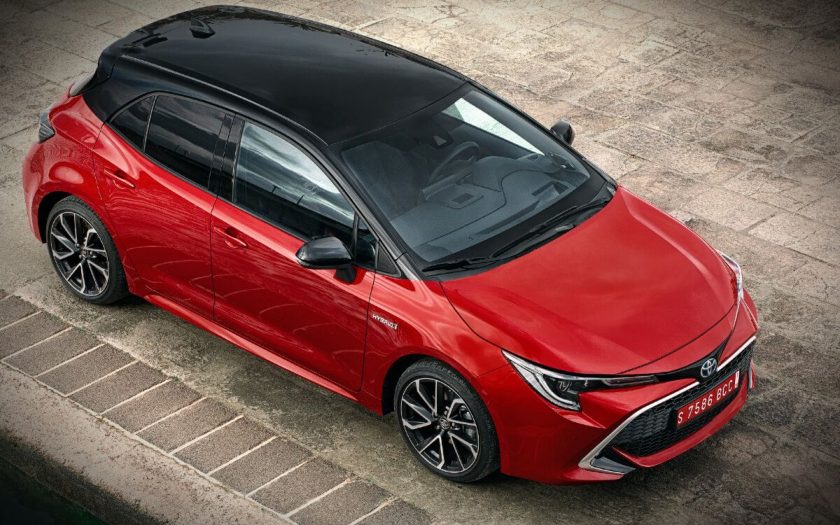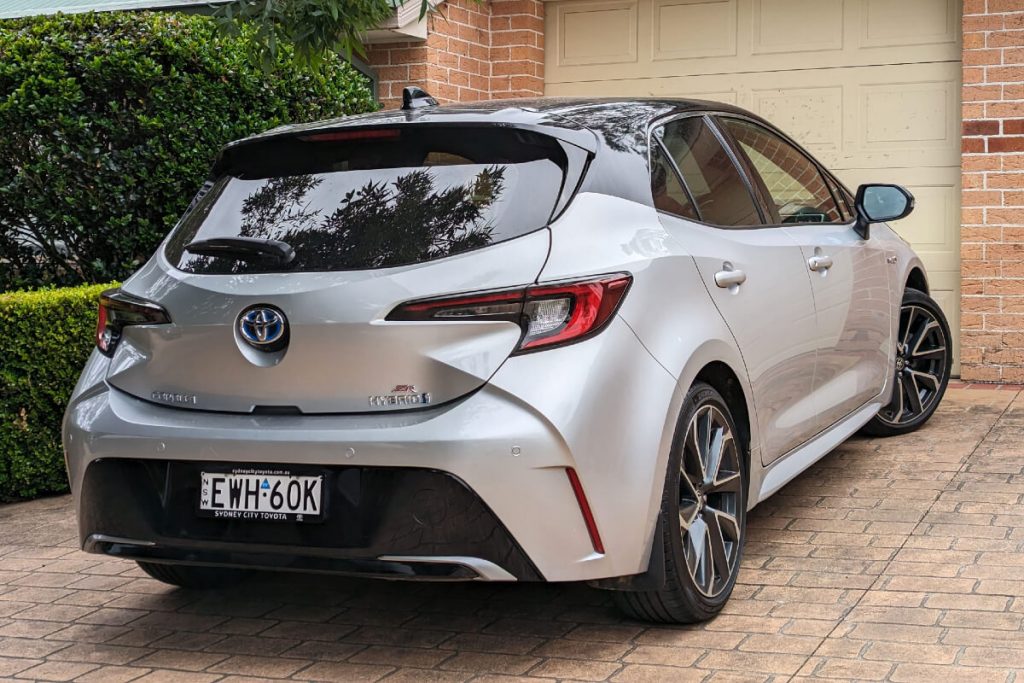Chris Riley tests the 2024 Toyota Corolla ZR 1.8-litre hybrid with pricing, specs, ride and handling, safety, verdict and everything the over-50 driver needs to know.
Summary: Toyota’s Corolla ZR hybrid once again showcases Toyota’s mastery of hybrid technology. And while sticker shock is a certainty, compared to the obvious competitors in the small passenger vehicle segment, it’s not overpriced.
2024 Toyota Corolla ZR 1.8-litre hybrid
Pricing: $39,100 (plus on road costs) Sounds high until you compare
Options: Two-tone paint $775
Warranty: Five-years/unlimited km No free roadside assist
Safety: Five-star ANCAP (tested 2018) Getting close to expiry
Build location: Japan
Engine: 1.8-litre naturally aspirated in line four-cylinder petrol plus 4.1Ah permanent magnet electric motor
Power: 72kW @ 5200rpm
Torque: 142Nm @ 3600rpm (petrol engine), 185Nm electric motor
Transmission: CVT automatic, front-wheel drive
Body: 4375mm (long); 1790mm (wide); 1435mm (high)
Kerb Weight: 1400kg
Braked towing capacity: 1300kg
Wheels: 18-inch alloy
Tyres: 225/40 R18
Ground clearance: 135mm You’ll need to take care over speed humps
Turning circle: 10.6m
Fuel tank capacity: 43 litres
Official consumption: 4.0L/100km (91 RON unleaded)
Consumption on test: 5.1L/100km (600km)
seniordriver consumption on test: not tested
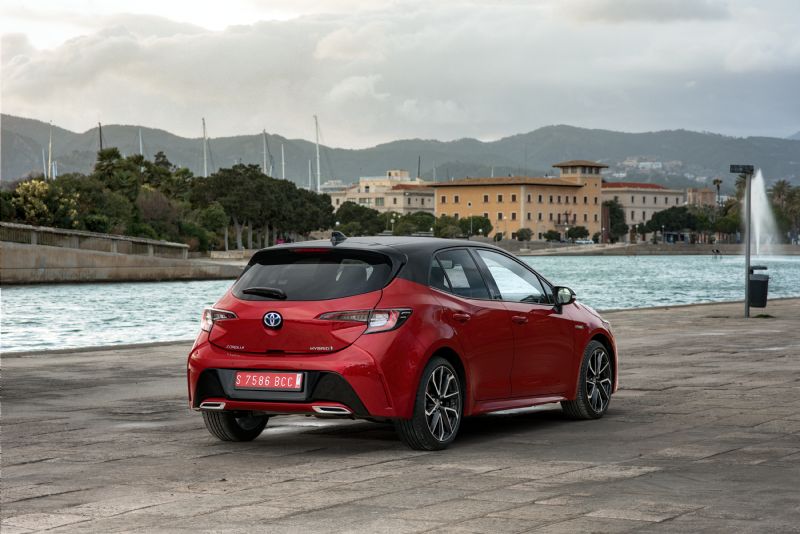
[review]
Finished in black over silver, Toyota’s ZR Corolla looks more eye-catching than ever.
In the past few years, the company has been able to transform the image of the car from staid and conservative into something much more sporty that has younger buyer appeal – at least that’s the plan.
Flanking the hatch is the more traditional sedan for mums and dads and the rally-bred, three-door, all-wheel drive GR hot hatch at the other end of the scale for the boy racers (and boy racers at heart).
Each grade of sedan and hatch is available with a petrol engine, or fuel-saving hybrid for another $2500 (obviously not the GR though).
The problem at the moment is probably going to be getting your hands on one, as the wait time for most Toyota models has blown out to at least 18 months – more so for hybrids.
In fact, Toyota recently pulled the plug on Camry Hybrid where the wait list is now two years.
Bugger!
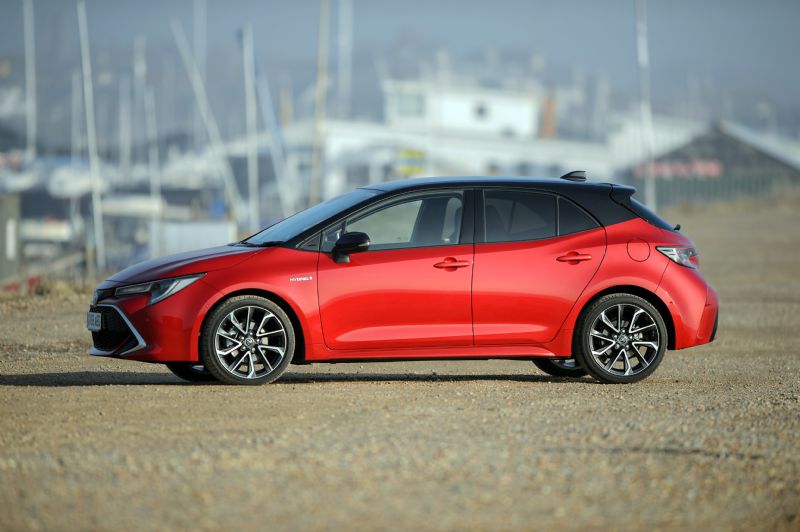
What’s it cost?
Corolla hatch starts from $29,610 for the Ascent Sport with a 2.0-litre petrol engine and automatic transmission.
The same car with a fuel-saving petrol-electric powertrain, a la Prius is an extra $2500, but will save you money in the long run.
Top of the range is the ZR Hybrid at $39,100 plus on roads, with a two-tone paint option for $775, offered in combination with white, grey, red, silver and blue.
There’s also the sporty, all-wheel drive GR Corolla from $64,190.
Our test vehicle, the ZR Hybrid hatch, is $44,394 by the time you put it on the road. And as good as it might be, that is a lot of Corolla.
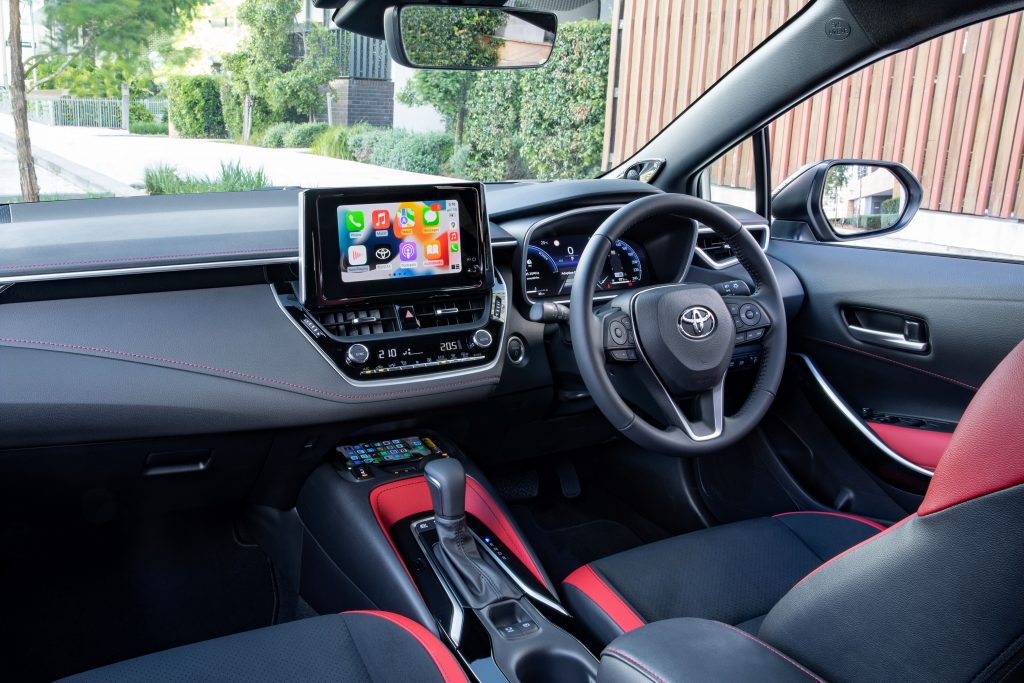
Standard kit includes 18-inch alloys, dual zone climate air and a combination of real and artificial suede trim, with heated sports seats up front with red accents and an eight-way power-adjust driver seat with lumbar support.
There’s also a premium gear lever and steering wheel, smart entry and start, electric parking brake, adaptive cruise control, road sign recognition, auto lights and wipers, auto-dimming rear-view mirror, front and rear parking sensors and rear privacy glass,
In the lights department, it has auto high beam, bi-LED headlights, along with LED daytime, tail and front/rear fog lights.
ZR steps up to a full 12.3-inch digital instrument cluster along with a windscreen head-up display.
Infotainment consists of an 8.0-inch touchscreen with premium JBL 8-speaker audio, plus Bluetooth, satellite navigation, AM/FM and DAB+ digital radio, and wired Apple CarPlay and Android Auto.
You also get 12 months of complimentary access with remote connect to Toyota Connect Services which automatically notifies emergency services in the event of an accident as well as provides remote access to the car.
There’s also a wireless charge pad, two USB-C ports and a 12-volt outlet in the front (but nothing for rear seat passengers).
Corolla has been awarded a full five stars for safety by ANCAP.
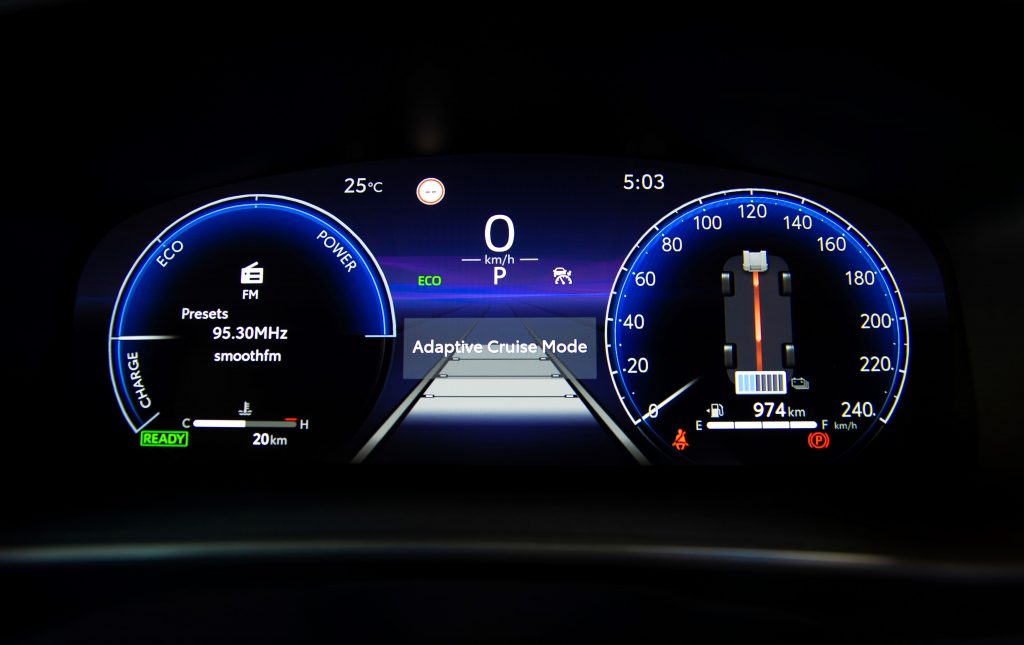
It comes with a rear-view camera, seven airbags including a driver knee airbag and autonomous emergency braking (City, Interurban & Vulnerable Road User) as well as lane keep assist (LKA) with lane departure warning (LDW).
An upgraded Toyota Safety Sense suite starts with the pre-collision safety system which adds motorcycle detection, intersection collision avoidance support for crossing vehicles and left/right turn, emergency steering assist and acceleration suppression at low speeds.
Cameras and radar sensors have also been improved offering a wider range for detection of obstacles or vehicles.
Blind spot monitor has been added across the hatch range, while lane keep assist has been expanded to include the emergency driving stop system feature that has been designed to bring the vehicle to a gradual stop if it detects the driver is no longer making vehicle inputs.
The active cruise control system has also been enhanced and now offers four distance settings, the ability to detect other vehicles earlier, and the addition of deceleration assist when changing lanes.
But it misses out on auto reverse braking.
ISOfix child restraint anchorage points are provided for the rear outboard seats.
Corolla comes with a five-year unlimited kilometre warranty.
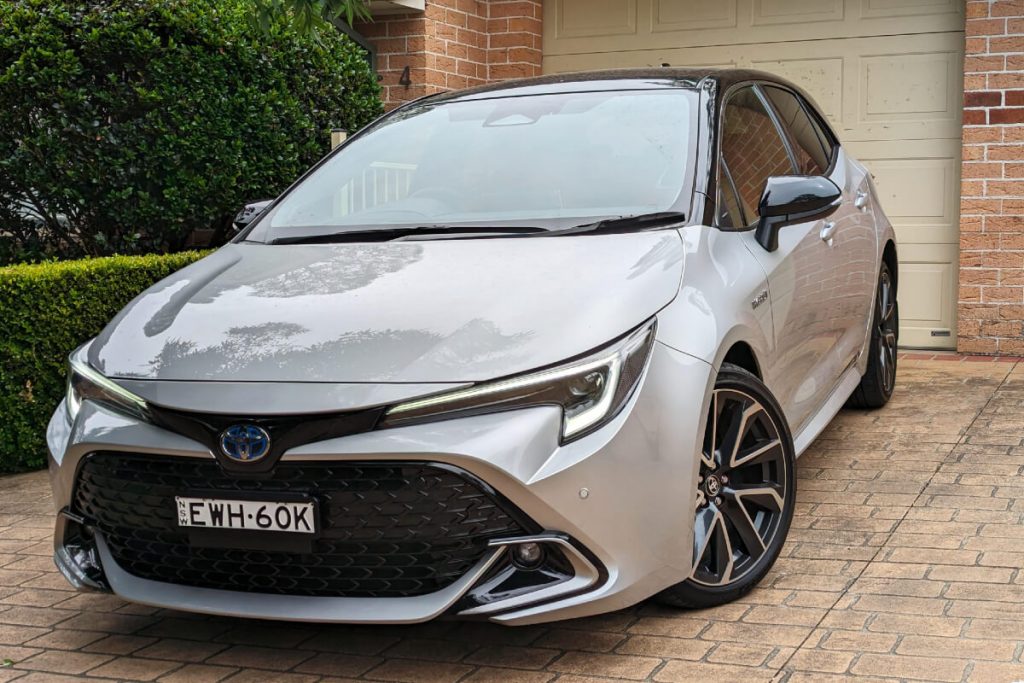
What’s it go like?
Corolla’s styling has evolved into something quite exceptional over the years, culminating in the latest ZR variant.
Launched 57 years ago, 12 generations later the hatch sports a low, wind-cheating profile that places the car quite close to the ground, which can pose problems.
It can make getting in and out difficult at times and it means driveways and speed humps need to be approached with caution, as the low front apron has a habit of scraping.
The sloping rear roof line also makes entry to the back more difficult than it probably should be, and you might find it a little cramped once you’re there.
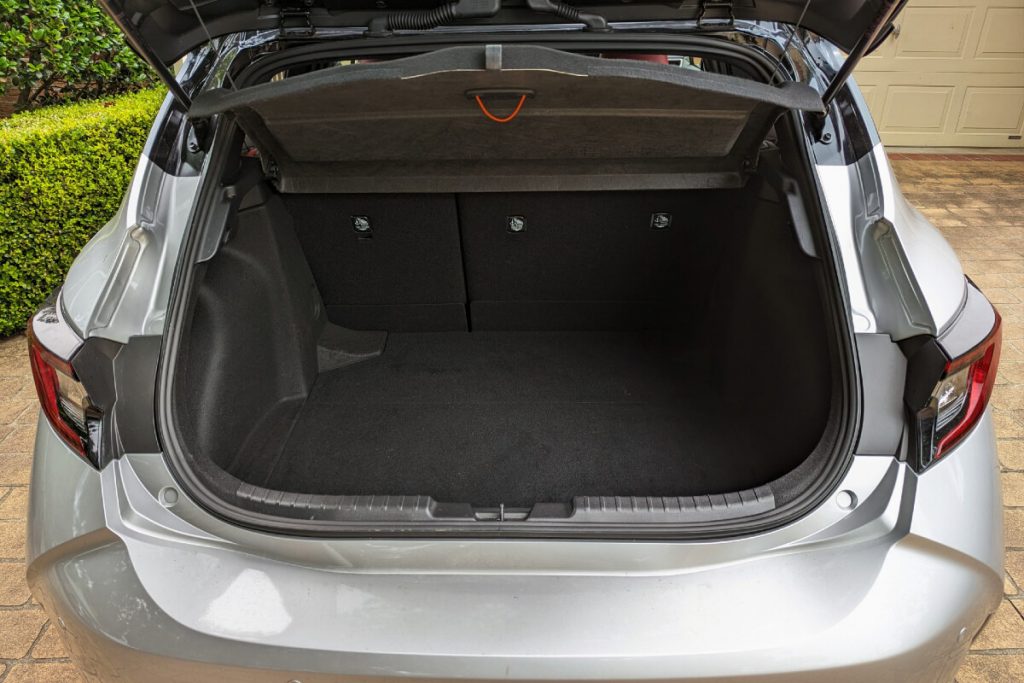
In the case of the hybrid, the boot is larger because it doesn’t get a spare wheel, temporary or otherwise, just a puncture repair kit – to make room for the battery pack.
ZR is available with a sporty 2.0-litre naturally aspirated engine or as a petrol-electric hybrid at a $2500 premium.
With the introduction of the upgraded fifth-generation hybrid powertrain, performance has been boosted with a 13kW increase in power to deliver a combined output of 103kW.
The upgraded hybrid teams a 1.8-litre petrol engine with a newly developed high-output motor generator, power control unit and downsized hybrid transaxle.
The front axle-mounted drive motor has been enhanced by doubling the number of magnets per pole inside the rotor, while the newly developed lithium-ion battery reduces weight by 14 percent while increasing both input and output power.
Hybrid grades drive the front wheels exclusively via a continuously variable transmission (CVT).
In comparison the 2.0-litre Toyota Dynamic Force inline four-cylinder engine produces 126kW/202Nm in the hatch and 126kW/203Nm for the sedan, driving the front wheels via a CVT with 10-speed sequential shift mode.
Of note, Corolla’s cousin the Lexus UX scores a larger 2.0-litre engine as the basis for its hybrid that produces a combined 135kW.
A couple of years ago, we once compared the petrol and hybrid hatch in a back-to-back test.
Both impressed, but for different reasons.
Apart from being powered by different drivetrains, there are other subtle differences.
For a start they have different transmissions. They’re both CVT autos – but with a difference.
One also gets gear change paddles, and the brakes are also different because of the hybrid’s regenerative braking requirements.
The instrumentation is also different, with a head-up display that shows different information.
The more you dig, the more you discover.
The petrol model is unquestionably the sportier of the two, but getting back into the hybrid after a long break, it feels sportier than we remember.
There’s a lot more tech this time around too.
Maybe I’m just getting old and soft. Or maybe my priorities have changed?
Putting the transmission of the hybrid in Power mode delivers more satisfying throttle response, with a turn of speed thanks to the boost from the electric motor.
But make sure you don’t pull the transmission lever back all the way or you’ll find yourself in B instead of D which is the regenerative braking mode. D is one step back.
The traffic sign monitor recognises speed signs only. It doesn’t recognise electronic speed signs, nor does it differentiate between standard signs, timed school zones or bus and truck advisory speed – so until it encounters a real speed sign it could be telling the driver the wrong thing.
Steering is sharp and the hatch corners flat and hard, but the ride is overly harsh and the cabin can become quite noisy, depending on the surface.
Toyota infamously doesn’t permit operation of the satellite navigation system while the car is on the move.
If you’re on the way somewhere and you forget to put in the address, it means pulling over and spending precious minutes on the task.
Or you can play beat the green light and try to enter the address before the lights change and it’s time to move off. Sluggish response from the touchscreen makes this almost impossible. You need to wait while it digests each letter, or you’ll find it skips every second one and you need to start again.
You could try appealing to the car’s voice activation system, but that’s an even more frustrating experience.
At the end of the day the hybrid is all about economy and this is where the Corolla aces it.
Rated at 4.0L/100km, we were getting 5.1L after more than 600km of mixed driving.
What we like
- Looks terrific
- Premium interior
- Sharp steering
- Solid planted feel
- Improved throttle response
- Uses very little fuel
What we don’t like
- Harsh ride
- Low spoiler scrapes driveways
- Easy to select B rather than D for transmission
- Touchscreen slow to boot and slow to respond
- Speed sign recognition needs some smarts
- Road noise deafening on coarse bitumen
What over-50s drivers need to know
Corolla has always appealed to older drivers, many of whom grew up behind the wheel of the car.
But after driving the sporty hatch it is easy to understand why Toyota produces a more conservative sedan version.
It’s not bad looking either and certainly easier to get in and out of.
The Corolla ZR Hybrid hatch sits lower and could present problems for the less agile driver.
Either way it’s a lot of car, and the price reflects this at well over $40K on the road.
It also has a lot of arguably better competition, but no one quite plays the hybrid card like Toyota, providing immediate, accessible, no frills fuel savings to the average motorist.
In this respect, it’s hard to beat.
seniordriver comments
The current Toyota Corolla is almost unrecognisable from the early models, but it still appeals to a conservative buyer profile, despite a hefty increase in price. It certainly no longer qualifies as an entry-level car!
However, we are always surprised every time we step into a Toyota by just how much things have improved. They look good, perform well and are very well finished. And Toyota has really raised the bar when it comes to hybrids.
Of course, for some reason, older buyers still tend to prefer the sedan over the hatch. Either way, you’re catered for.
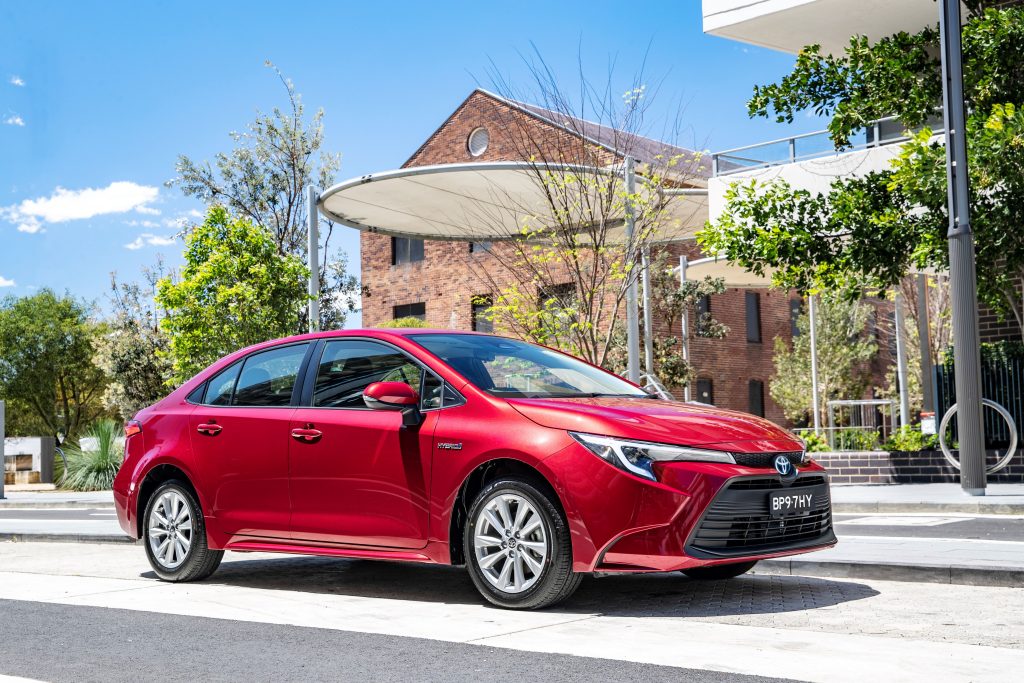
We’ve received numerous reports of extremely long wait times for Toyotas, and especially hybrid variants. Readers have told us they’ve settled for other brands rather than wait 18 months (or more) for their preferred Toyota model. It’s a problem Toyota will need to address, and quickly.
The lack of auto reverse braking is a strange omission on an otherwise-well-equipped car.
And the ANCAP testing was done way back in 2018 so it is not quite as impressive as its five-star rating at first appears. No doubt, Toyota will be looking at renewed testing in the near future. We certainly hope so.
Low ground clearance (the hybrid actually sits 5mm higher than the non-hybrid variant) can be an issue, especially if you regularly face speed humps or have a difficult driveway. And the sloping roofline steal head room and making it more difficult getting in and out.
The CVT auto isn’t as annoying as many of its ilk, and its nominally rated as 10-speed.
We’ve noticed that Toyota speed sign recognition is a bit hit and miss and surely, in this day and age, it can be calibrated to read the increasingly common electronic speed signs? As for the voice activation system, the less said the better. We tried multiple times to try and get the system to make a phone call to one of the contacts on my list and finally gave up, pulled over and entered the number manually.
